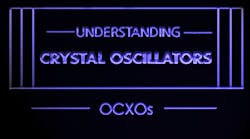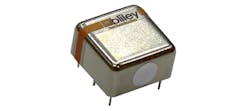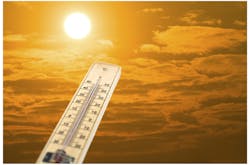Download this article as a .PDF
Oven-controlled crystal oscillators (OCXOs) are used in applications where a very high degree of frequency stability is required. Sometimes these oscillators may even be referred to as temperature-stabilized crystal oscillators, or just crystal ovens.
While crystal oscillators show a high degree of stability even when the outside temperature is varied over a significant range, for some applications even higher levels of temperature stability are required. In these applications, OCXOs may provide the required solution.
As with many other crystal-based products, OCXOs are available in a wide variation of packages and package styles. The performance levels and costs also need to be considered, as these can vary considerably, as well.
It’s Getting Hot in Here—Effects of Temperature on the OCXO
It is still sometimes necessary to ensure an even better degree of stability. This can be achieved by placing the crystal in a thermally insulated container with a thermostatically controlled heater. By heating the crystal to a temperature above that which would normally be encountered within the electronic equipment, the temperature of the crystal can be maintained at a constant temperature. This results in a far greater degree of temperature stability. Additionally, the crystal in the OCXO will be cut to ensure that its temperature stability is optimized for the internal operating temperature.
The internal temperature for a crystal oven is commonly run at a temperature of 75°C. The temperature needs to be above the highest temperature likely to be encountered—otherwise, the temperature control will not work.
The typical specification for an OCXO might be ±5 × 10-8 per degree Celsius (0.05 ppm), whereas a non-oven controlled oscillator may be between 10 and 100 times poorer. As the oscillator assembly will also contain buffering circuitry, as well as supply voltage regulation, the other characteristics of the oscillator should also be good. Typically, it might be expected that frequency stability would be around ±5 × 10-9 (0.005 ppm) per day and ±5 × 10-7 (0.5 ppm) per year, and 1 × 10-7 for a 5% change in supply voltage. These are far better than would be expected from a simple crystal oscillator.
To ensure that the optimum overall accuracy is maintained, combating elements such as aging of the crystal itself is needed. A periodic calibration of the OCXO may be required. Typical calibration periods may be of the order of six months to a year, but the actual period will depend upon the OCXO itself and the requirements of the application in which it is being used.
OCXO Physical Considerations
OCXOs are physically much larger than a simple crystal oscillator. Not only do they need to incorporate the crystal oscillator itself, but also the heater, control circuitry, and the thermal insulation around the crystal oscillator.
Typically, the heater will be run from a different supply to the oscillator. It does not need the same level of regulation, and indeed the oscillator is most likely to have its own regulator to remove any stray noise and RF that may appear on the supply line and thereby degrade the performance of the OCXO.
The supply for the heater in the OCXO may be quite current hungry. Some units may require an amp or so on warm-up. This figure will reduce as the temperature inside the OCXO rises and less heat is needed. As will be imagined, the temperature is thermostatically controlled.
These OCXO units are naturally more expensive than crystals on their own, but the performance of an OCXO is considerably enhanced on that of a simple crystal in an unregulated electrical and physical environment. They also consume much more power than a traditional crystal or non-ovenized oscillator. This is considered one of the main drawbacks of OCXOs and has driven the rise of a new class of low-power OCXOs that draw significantly less power than traditional ovens.



